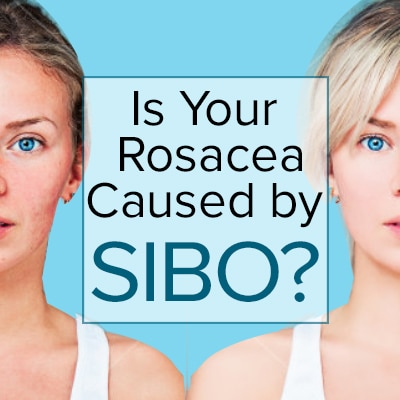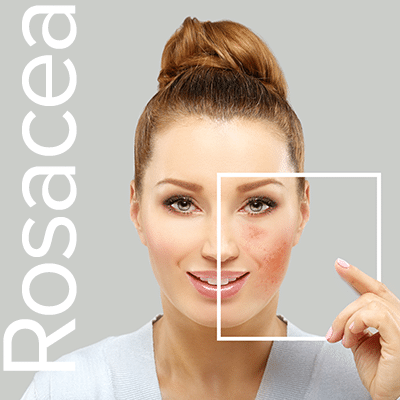Is Your Rosacea Caused by SIBO?

Anyone who has suffered from rosacea can tell you how frustrating and even embarrassing the condition can be.
If rosacea progresses long enough, it can actually become downright painful. Confidence, self-esteem, and emotional well-being can also be negatively affected by rosacea.
And in some of the worst cases, people worry about going out in public.
Isn’t it time that we found a solution to debilitating skin conditions like rosacea?
What we’re discovering about rosacea and so many other skin conditions, is that the problem isn’t with the skin itself – instead, the problem often lies within the gut.
While this might be surprising for some, many who have had skin conditions such as rosacea, eczema, and psoriasis have experienced firsthand the disappointing results of skin care products available.
This has caused many to wonder why it is creams and lotions can’t solve many skin conditions.
This is because your gut and your skin are closely associated through what’s called the gut-skin axis. What happens is conditions of the gut manifest in symptoms on the skin.
Your skin is an important part of your immune system, which is partly why it’s so closely associated with the gut.
Your skin is your first line of defense from the rest of the outside world, while the gut is the first line of defense for anything that is consumed internally.
When there is inflammation or dysbiosis of the gut, it can cause flare-ups on the skin.
In the case of rosacea, one particular gut condition has been observed to be the most common culprit – and that is small intestinal bacterial overgrowth (SIBO).
What is SIBO?
Hopefully, by now you’ve heard of your gut microbiome, which refers to the trillions of bacteria and other microbes that reside in your gut and influence every aspect of your health.
Your gut microbiome is proving to be incredibly important for daily functions and overall health.
What many people don’t realize is that most of these bacteria should exist in the stomach, large intestine, and colon – but not so much in the small intestine.
Your small intestine is the largest section of your gastrointestinal tract. This section is extremely important for absorbing nutrients.
When somebody has SIBO, methane-producing archaebacteria migrate down into the small intestine, where they don’t belong. What happens next is an overproduction of methane and hydrogen gas.
These gases can cause bloating, abdominal pain, constipation or diarrhea.
However, perhaps the most important reason SIBO isn’t good for your health is that it interrupts nutrient absorption.
We need nutrients to keep the millions of functions within our bodies running smoothly. When nutrient absorption is interrupted, it can cause all sorts of unusual symptoms outside of the gastrointestinal tract.
For example, another common symptom associated with SIBO is brain fog. This is how SIBO infiltrates your day-to-day life and contributes to other conditions such as rosacea.
How Do You Know if You Have SIBO?

If you have rosacea you might be wondering if it’s possible that you also have small intestine bacterial overgrowth. Here are some of the most common signs of SIBO:
- Bloating
- Abdominal pain
- Gas
- Constipation
- Diarrhea
- Food allergies
- Nutrient deficiencies
- And of course, rosacea
Furthermore, people who have SIBO also usually have other conditions, such as irritable bowel syndrome.
Also, common gut triggers are also triggers of rosacea, such as alcohol, gluten, spicy food, and stress.
Study Finds Healing Your SIBO Means Healing Your Rosacea
A 2008 study found that rosacea patients were significantly more likely to have SIBO.
What is more interesting, is that when there was a full eradication of SIBO in the rosacea patients, there was almost a complete regression of the rosacea symptoms.
Bottom line: The results of SIBO eradication caused a complete reduction in rosacea symptoms that lasted up to nine months.
What an exciting study!
This means that when a rosacea patient takes the necessary steps to correct gut health issues, especially SIBO, they might experience a reduction of their painful and frustrating rosacea symptoms.
How to Naturally Treat SIBO
If you think you have SIBO, one of the best things you can do is correct your diet so it starves the harmful bacteria. This means eliminating sugar, refined carbohydrates, and alcohol.
You also should make an appointment with your gastroenterologist, so you can have a SIBO breath test done.
The SIBO breath test is a non-invasive procedure that consists of you blowing into a balloon a few times over a few hours.
To take treating SIBO to the next level, you can also consider getting on a low FODMAP diet. The low FODMAP diet further reduces the amount of sugar and carbohydrates you’re consuming by eliminating certain fruits and vegetables.
The low FODMAP diet isn’t meant to be a complete lifestyle change, but a temporary fix to reduce harmful bacteria in the gut.
Overall, the low FODMAP diet includes removing foods such as:
- Artichokes
- Garlic
- Leeks
- Onions
- Dairy products
- Beans
- Wheat and barley products
- Many fruits
You can also consider taking helpful supplements that reduce your SIBO symptoms. These can bring you a lot of relief in a relatively short time.
When it comes the gastrointestinal discomfort, there’s no need to grin and bear it any longer. In fact, when you experience symptoms such as bloating, gas, constipation, and diarrhea, it’s your gut trying to tell you something.
Make sure to listen to your gut and address any symptoms – immediately – with solutions that provide actual relief through addressing the root cause.
This is the only way to make sure conditions like SIBO don’t progress into other manifestations, such as rosacea.